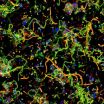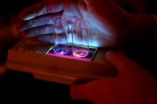In one of two studies conducted by researchers at the Kennedy Krieger Institute in Baltimore, MD and the Cincinnati Children's Hospital Medical Center, children with ADHD performed a finger-tapping task. Any unintentional "overflow" movements occurring on the opposite hand were noted. Children with ADHD showed more than twice the amount of overflow than typically developing children. This is the first time that scientists have been able to quantify the degree to which ADHD is associated with a failure in motor control.
The single most common child behavioral diagnosis, ADHD is a highly prevalent developmental disorder characterized by inattentiveness, hyperactivity and impulsivity. The approximately 2 million affected children often fall behind their peers in development of motor control, motor overflow (unintentional movement) and balance. The inability to control or inhibit voluntary actions is suspected to contribute to the core diagnostic features of excessive hyperactivity, impulsivity and off-task (distractible) behavior.
"Despite its prevalence, there is a lack of understanding about the neurobiological basis of ADHD," said Dr. Stewart Mostofsky, the study's senior author and Director of the Laboratory for Neurocognitive and Imaging Research at the Kennedy Krieger Institute. "A critical obstacle in ADHD is the lack of quantitative measures of brain function that would provide a basis for more accurate diagnosis and effective treatment."
In the study, researchers looked at 50 right-handed children – 25 with ADHD and 25 typically developing, ages 8-12 years. Each subject completed five tasks of sequential finger-tapping on each hand. In this exercise, the children tapped each finger to the thumb of the same hand, in sequence. The tapping hand alternated between left-handed finger sequencing and right-handed finger sequencing. Excessive mirror overflow, defined as unintentional and unnecessary movements occurring in the same muscles on the opposite side of the body, were measured using video and a device that recorded finger position. These methods provided precise quantification of the amount of overflow movement, a major advance over prior studies that relied on qualitiative scales. During left-handed finger tapping, children with ADHD showed more than twice as much mirror overflow than typically developing children. The differences were particularly prominent for boys with ADHD who showed nearly four times as much mirror overflow than typically developing boys on one of the two measures used in the study.
"This study used quantitative measures to support past qualitative findings that motor overflow persists to a greater degree in children with ADHD than in typically developing peers," said Dr. Mostofsky. "The findings reveal that even at an unconscious level, these children are struggling with controlling and inhibiting unwanted actions and behavior. Studying motor control weakness gives us a window to understanding the similar challenges that children with ADHD face in controlling more complex behavior, which can lead to improved diagnosis and treatment."
In a second study, the researchers investigated motor control in children with ADHD further by measuring activity within the motor cortex, the part of the brain that controls voluntary movement. Researchers used Transcranial Magnetic Stimulation (TMS) to apply mild magnetic pulses for brief durations to trigger muscle activity in the hand, causing hand twitches. Researchers performed 60 trials, with single or paired pulses to measure the level of muscle activity and monitored the resulting brain activity, called short interval cortical inhibition (SICI). Overall, children with ADHD showed a substantial decrease in SICI, with significantly less inhibition of motor activity during the paired pulse stimulation compared to typically developing children. The degree of inhibition in children with ADHD, measured by SICI, was 40 percent less than typically developing children. Furthermore, within the ADHD group, less motor inhibition (decreased SICI) correlated with more severe symptoms. The measure of SICI not only predicted motor impairment in ADHD children but also robustly predicted their behavioral symptoms as reported by parents. The findings suggest that reduced SICI may be a critical biomarker of ADHD.
"The neurobiological underpinnings of motor delays and behavioral symptoms in ADHD are not well understood," said Dr. Donald Gilbert, study author and Director of the Transcranial Magnetic Stimulation Laboratory at the Cincinnati Children's Hospital Medical Center. "However, our study provides more insight into the physiological measures of this disorder. We found SICI to be an important biomarker for predicting ADHD symptoms and severity, and it is a highly quantifiable and reproducible measure. This offers a foundation for determining which children are at higher risk for severe and ongoing symptoms as they grow older."
INFORMATION:
These studies were principally supported by grants from the National Institutes of Health.
About the Kennedy Krieger Institute
Internationally recognized for improving the lives of children and adolescents with disorders and injuries of the brain and spinal cord, the Kennedy Krieger Institute in Baltimore, MD serves more than 16,000 individuals each year through inpatient and outpatient clinics, home and community services and school-based programs. Kennedy Krieger provides a wide range of services for children with developmental concerns mild to severe, and is home to a team of investigators who are contributing to the understanding of how disorders develop while pioneering new interventions and earlier diagnosis. For more information on Kennedy Krieger Institute, visit www.kennedykrieger.org.
About the Cincinnati Children's Hospital Medical Center
Cincinnati Children's Hospital Medical Center is one of just eight children's hospitals named to the Honor Roll in U.S. News and World Report's 2010-11 Best Children's Hospitals. It is ranked #1 for digestive disorders and highly ranked for its expertise in pulmonology, cancer, neonatology, heart and heart surgery, neurology and neurosurgery, diabetes and endocrinology, orthopedics, kidney disorders and urology. Cincinnati Children's is one of the top two recipients of pediatric research grants from the National Institutes of Health. It is internationally recognized for quality and transformation work by Leapfrog, The Joint Commission, the Institute for Healthcare Improvement, the federal Agency for Healthcare Research and Quality, and by hospitals and health organizations it works with globally. Additional information can be found at www.cincinnatichildrens.org.
END






